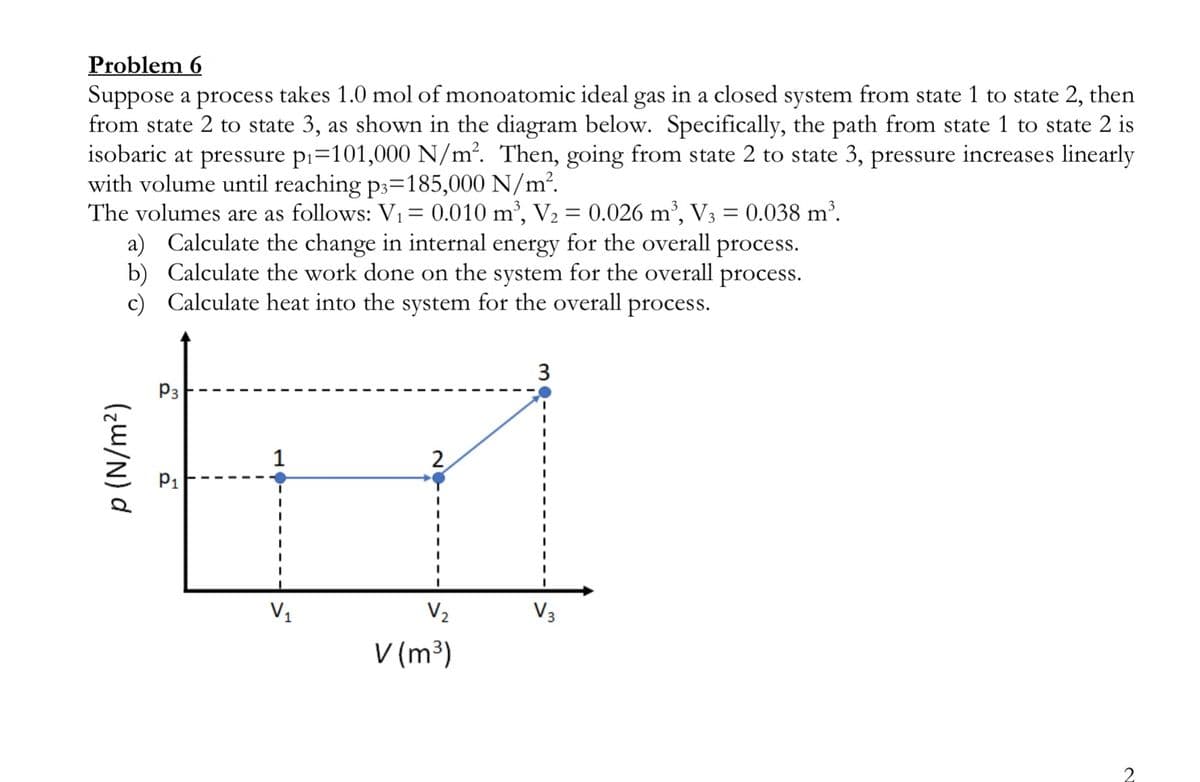Problem 6 Suppose a process takes 1.0 mol of monoatomic ideal gas in a closed system from state 1 to state 2, then from state 2 to state 3, as shown in the diagram below. Specifically, the path from state 1 to state 2 is isobaric at pressure pi=101,000 N/m?. Then, going from state 2 to state 3, pressure increases linearly with volume until reaching p3=185,000 N/m². The volumes are as follows: V1= 0.010 m², V2 = 0.026 m², V3 = 0.038 m. a) Calculate the change in internal energy for the overall process. b) Calculate the work done on the system for the overall process. c) Calculate heat into the system for the overall process. 3 P3 1 P1 V, V2 V (m³) p (N/m²)
Problem 6 Suppose a process takes 1.0 mol of monoatomic ideal gas in a closed system from state 1 to state 2, then from state 2 to state 3, as shown in the diagram below. Specifically, the path from state 1 to state 2 is isobaric at pressure pi=101,000 N/m?. Then, going from state 2 to state 3, pressure increases linearly with volume until reaching p3=185,000 N/m². The volumes are as follows: V1= 0.010 m², V2 = 0.026 m², V3 = 0.038 m. a) Calculate the change in internal energy for the overall process. b) Calculate the work done on the system for the overall process. c) Calculate heat into the system for the overall process. 3 P3 1 P1 V, V2 V (m³) p (N/m²)
Elements Of Electromagnetics
7th Edition
ISBN:9780190698614
Author:Sadiku, Matthew N. O.
Publisher:Sadiku, Matthew N. O.
ChapterMA: Math Assessment
Section: Chapter Questions
Problem 1.1MA
Related questions
Question

Transcribed Image Text:Problem 6
Suppose a process takes 1.0 mol of monoatomic ideal gas in a closed system from state 1 to state 2, then
from state 2 to state 3, as shown in the diagram below. Specifically, the path from state 1 to state 2 is
isobaric at pressure pi=101,000 N/m². Then, going from state 2 to state 3, pressure increases linearly
with volume until reaching p3=185,000 N/m².
The volumes are as follows: V1= 0.010 m², V2 = 0.026 m³, V3 = 0.038 m³.
a) Calculate the change in internal energy for the overall process.
b) Calculate the work done on the system for the overall process.
c) Calculate heat into the system for the overall process.
3
P3
1
2
P1
V1
V2
V3
V (m³)
p (N/m²)
Expert Solution
This question has been solved!
Explore an expertly crafted, step-by-step solution for a thorough understanding of key concepts.
This is a popular solution!
Trending now
This is a popular solution!
Step by step
Solved in 3 steps

Knowledge Booster
Learn more about
Need a deep-dive on the concept behind this application? Look no further. Learn more about this topic, mechanical-engineering and related others by exploring similar questions and additional content below.Recommended textbooks for you

Elements Of Electromagnetics
Mechanical Engineering
ISBN:
9780190698614
Author:
Sadiku, Matthew N. O.
Publisher:
Oxford University Press

Mechanics of Materials (10th Edition)
Mechanical Engineering
ISBN:
9780134319650
Author:
Russell C. Hibbeler
Publisher:
PEARSON

Thermodynamics: An Engineering Approach
Mechanical Engineering
ISBN:
9781259822674
Author:
Yunus A. Cengel Dr., Michael A. Boles
Publisher:
McGraw-Hill Education

Elements Of Electromagnetics
Mechanical Engineering
ISBN:
9780190698614
Author:
Sadiku, Matthew N. O.
Publisher:
Oxford University Press

Mechanics of Materials (10th Edition)
Mechanical Engineering
ISBN:
9780134319650
Author:
Russell C. Hibbeler
Publisher:
PEARSON

Thermodynamics: An Engineering Approach
Mechanical Engineering
ISBN:
9781259822674
Author:
Yunus A. Cengel Dr., Michael A. Boles
Publisher:
McGraw-Hill Education

Control Systems Engineering
Mechanical Engineering
ISBN:
9781118170519
Author:
Norman S. Nise
Publisher:
WILEY

Mechanics of Materials (MindTap Course List)
Mechanical Engineering
ISBN:
9781337093347
Author:
Barry J. Goodno, James M. Gere
Publisher:
Cengage Learning

Engineering Mechanics: Statics
Mechanical Engineering
ISBN:
9781118807330
Author:
James L. Meriam, L. G. Kraige, J. N. Bolton
Publisher:
WILEY